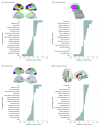Multivariate Associations Among Behavioral, Clinical, and Multimodal Imaging Phenotypes in Patients With Psychosis
- PMID: 29516092
- PMCID: PMC5875357
- DOI: 10.1001/jamapsychiatry.2017.4741
Multivariate Associations Among Behavioral, Clinical, and Multimodal Imaging Phenotypes in Patients With Psychosis
Abstract
Importance: Alterations in multiple neuroimaging phenotypes have been reported in psychotic disorders. However, neuroimaging measures can be influenced by factors that are not directly related to psychosis and may confound the interpretation of case-control differences. Therefore, a detailed characterization of the contribution of these factors to neuroimaging phenotypes in psychosis is warranted.
Objective: To quantify the association between neuroimaging measures and behavioral, health, and demographic variables in psychosis using an integrated multivariate approach.
Design, setting, and participants: This imaging study was conducted at a university research hospital from June 26, 2014, to March 9, 2017. High-resolution multimodal magnetic resonance imaging data were obtained from 100 patients with schizophrenia, 40 patients with bipolar disorder, and 50 healthy volunteers; computed were cortical thickness, subcortical volumes, white matter fractional anisotropy, task-related brain activation (during working memory and emotional recognition), and resting-state functional connectivity. Ascertained in all participants were nonimaging measures pertaining to clinical features, cognition, substance use, psychological trauma, physical activity, and body mass index. The association between imaging and nonimaging measures was modeled using sparse canonical correlation analysis with robust reliability testing.
Main outcomes and measures: Multivariate patterns of the association between nonimaging and neuroimaging measures in patients with psychosis and healthy volunteers.
Results: The analyses were performed in 92 patients with schizophrenia (23 female [25.0%]; mean [SD] age, 27.0 [7.6] years), 37 patients with bipolar disorder (12 female [32.4%]; mean [SD] age, 27.5 [8.1] years), and 48 healthy volunteers (20 female [41.7%]; mean [SD] age, 29.8 [8.5] years). The imaging and nonimaging data sets showed significant covariation (r = 0.63, P < .001), which was independent of diagnosis. Among the nonimaging variables examined, age (r = -0.53), IQ (r = 0.36), and body mass index (r = -0.25) were associated with multiple imaging phenotypes; cannabis use (r = 0.23) and other substance use (r = 0.33) were associated with subcortical volumes, and alcohol use was associated with white matter integrity (r = -0.15). Within the multivariate models, positive symptoms retained associations with the global neuroimaging (r = -0.13), the cortical thickness (r = -0.22), and the task-related activation variates (r = -0.18); negative symptoms were mostly associated with measures of subcortical volume (r = 0.23), and depression/anxiety was associated with measures of white matter integrity (r = 0.12).
Conclusions and relevance: Multivariate analyses provide a more accurate characterization of the association between brain alterations and psychosis because they enable the modeling of other key factors that influence neuroimaging phenotypes.
Conflict of interest statement
Figures


Similar articles
-
Association of White Matter With Core Cognitive Deficits in Patients With Schizophrenia.JAMA Psychiatry. 2017 Sep 1;74(9):958-966. doi: 10.1001/jamapsychiatry.2017.2228. JAMA Psychiatry. 2017. PMID: 28768312 Free PMC article.
-
Mapping the Heterogeneous Phenotype of Schizophrenia and Bipolar Disorder Using Normative Models.JAMA Psychiatry. 2018 Nov 1;75(11):1146-1155. doi: 10.1001/jamapsychiatry.2018.2467. JAMA Psychiatry. 2018. PMID: 30304337 Free PMC article.
-
Disruption of Conscious Access in Psychosis Is Associated with Altered Structural Brain Connectivity.J Neurosci. 2021 Jan 20;41(3):513-523. doi: 10.1523/JNEUROSCI.0945-20.2020. Epub 2020 Nov 23. J Neurosci. 2021. PMID: 33229501 Free PMC article.
-
Meta-analysis of functional magnetic resonance imaging studies of timing and cognitive control in schizophrenia and bipolar disorder: Evidence of a primary time deficit.Schizophr Res. 2017 Oct;188:21-32. doi: 10.1016/j.schres.2017.01.039. Epub 2017 Feb 4. Schizophr Res. 2017. PMID: 28169089 Review.
-
Structural and functional neuroimaging studies in major depressive disorder with psychotic features: a critical review.Schizophr Bull. 2013 Jul;39(4):776-86. doi: 10.1093/schbul/sbt054. Epub 2013 Apr 24. Schizophr Bull. 2013. PMID: 23615813 Free PMC article. Review.
Cited by
-
Resting-state brain functional alterations and their genetic mechanisms in drug-naive first-episode psychosis.Schizophrenia (Heidelb). 2023 Feb 25;9(1):13. doi: 10.1038/s41537-023-00338-z. Schizophrenia (Heidelb). 2023. PMID: 36841861 Free PMC article.
-
Multivariate analytical approaches for investigating brain-behavior relationships.Front Neurosci. 2023 Jul 31;17:1175690. doi: 10.3389/fnins.2023.1175690. eCollection 2023. Front Neurosci. 2023. PMID: 37583413 Free PMC article.
-
Multivariate patterns of brain-behavior associations across the adult lifespan.Aging (Albany NY). 2022 Jan 10;14(1):161-194. doi: 10.18632/aging.203815. Epub 2022 Jan 10. Aging (Albany NY). 2022. PMID: 35013005 Free PMC article.
-
Label-free proteomics differences in the dorsolateral prefrontal cortex between bipolar disorder patients with and without psychosis.J Affect Disord. 2020 Jun 1;270:165-173. doi: 10.1016/j.jad.2020.03.105. Epub 2020 Apr 8. J Affect Disord. 2020. PMID: 32339108 Free PMC article.
-
Covariation of preadult environmental exposures, adult brain imaging phenotypes, and adult personality traits.Mol Psychiatry. 2023 Nov;28(11):4853-4866. doi: 10.1038/s41380-023-02261-2. Epub 2023 Sep 22. Mol Psychiatry. 2023. PMID: 37737484
References
-
- Peralta V, Moreno-Izco L, Calvo-Barrena L, Cuesta MJ. The low- and higher-order factor structure of symptoms in patients with a first episode of psychosis. Schizophr Res. 2013;147(1):116-124. - PubMed
Publication types
MeSH terms
Grants and funding
LinkOut - more resources
Full Text Sources
Other Literature Sources
Medical

